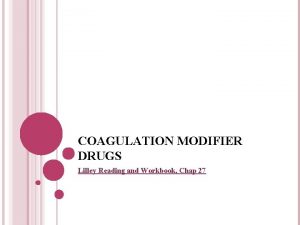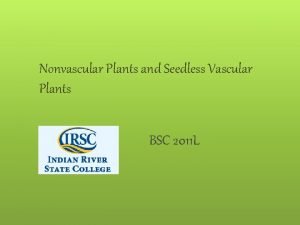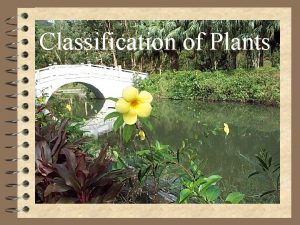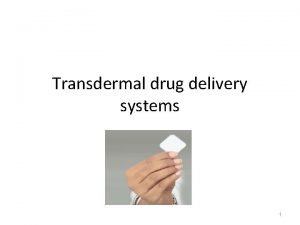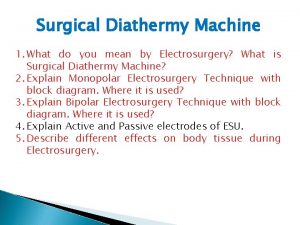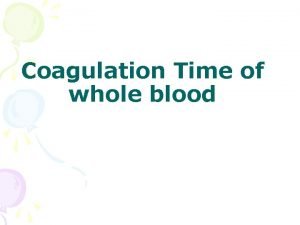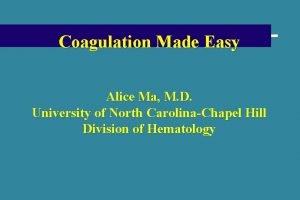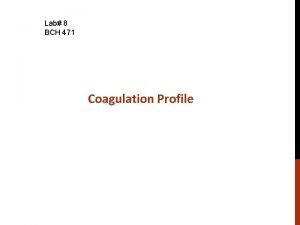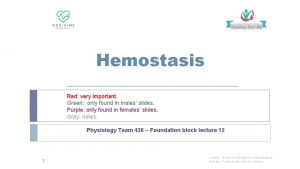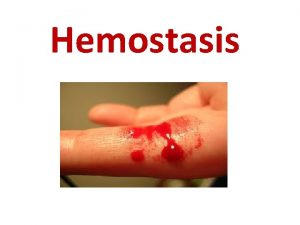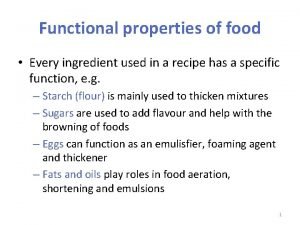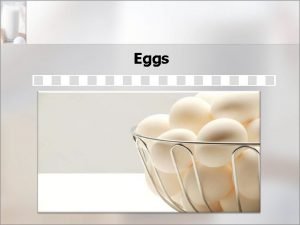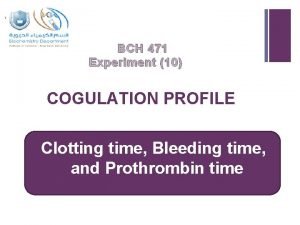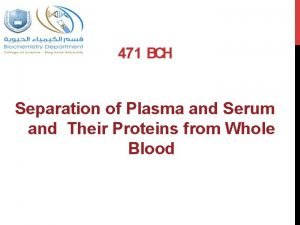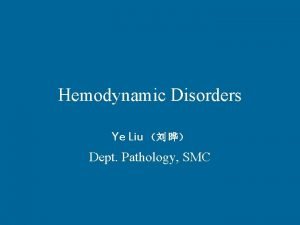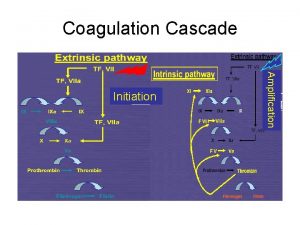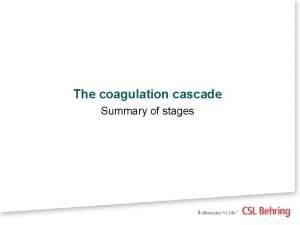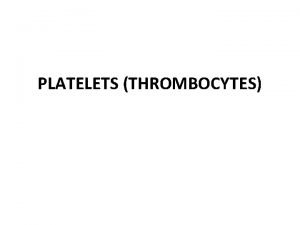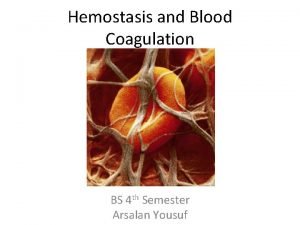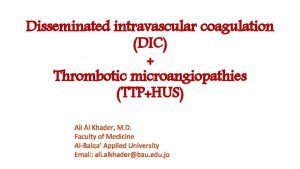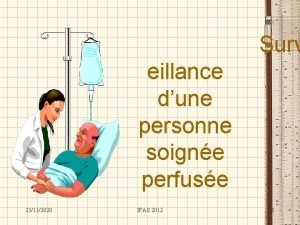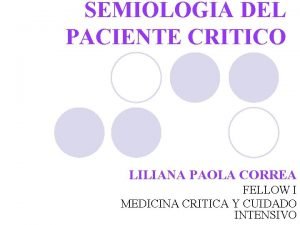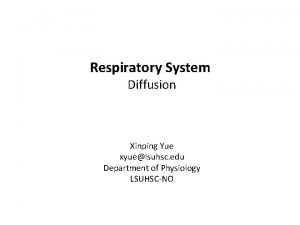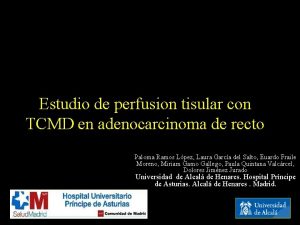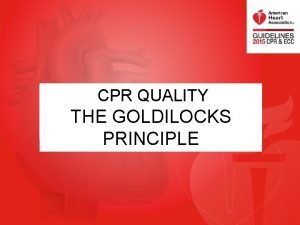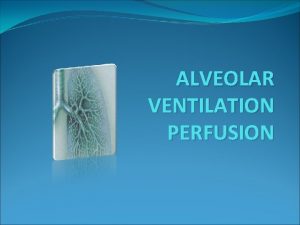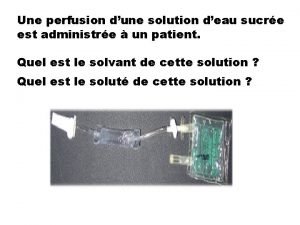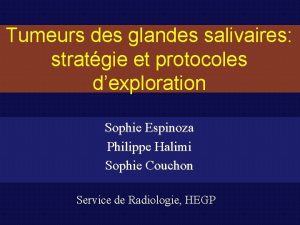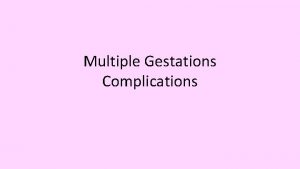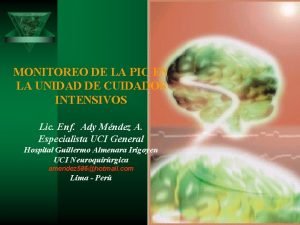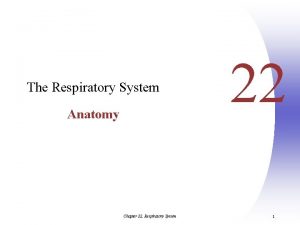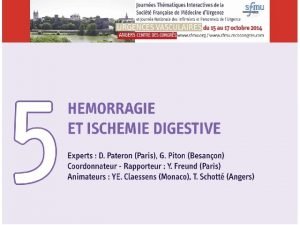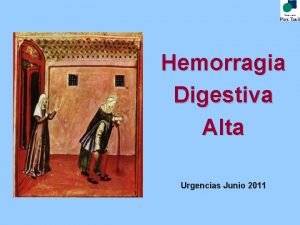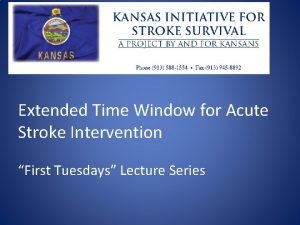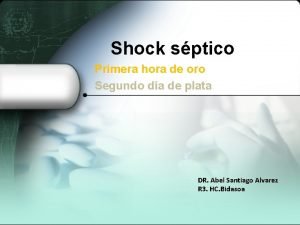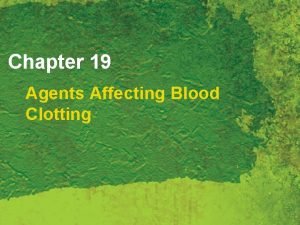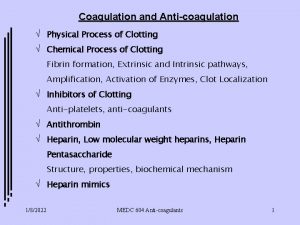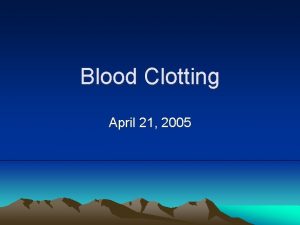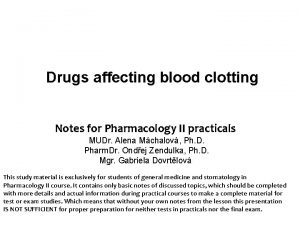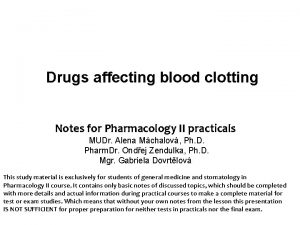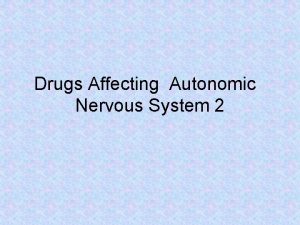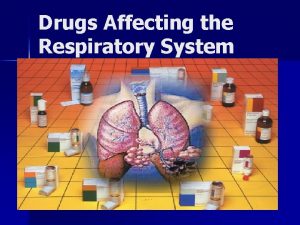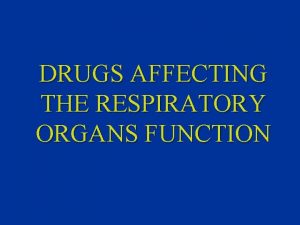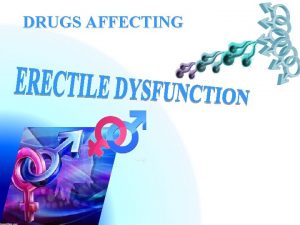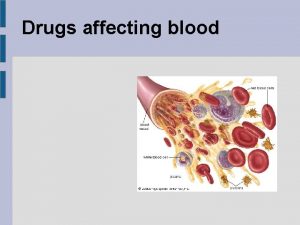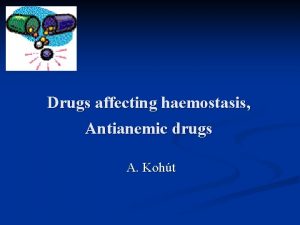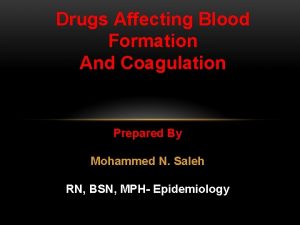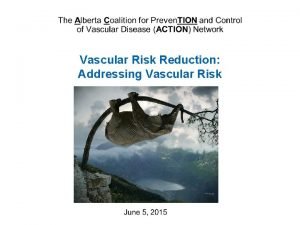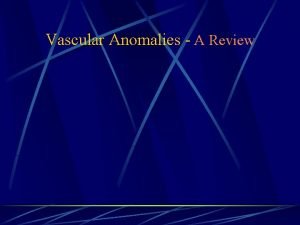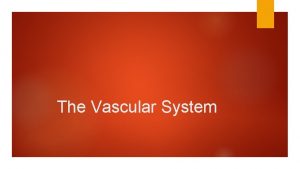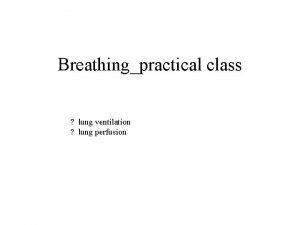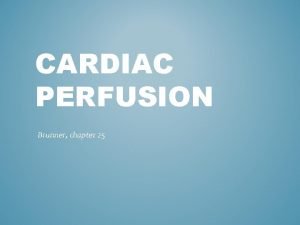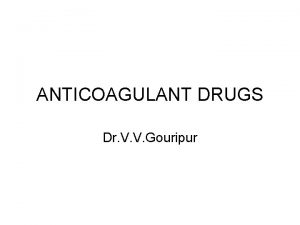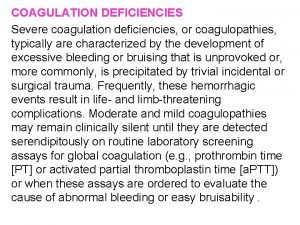Vascular Perfusion Drugs Affecting Coagulation Clotting The process









































- Slides: 41

Vascular Perfusion: Drugs Affecting Coagulation

Clotting • The process in which blood is converted to a semi-solid gel. • When clotting doesn’t occur patients are at risk for bleeding. • When too much clotting occurs blood flow can be obstructed to major organs.

Physiology of Coagulation • Blood circulates freely through large and small blood vessels. • Vessels must be able to form clots to prevent excessive blood loss from injuries. • Blood is composed of various cells and substances, each assisting in maintaining a balance of coagulation and anticoagulation.

Physiology of Coagulation • The coagulation cascade is initiated by tissue damage and platelet activation, which mobilize the clotting factors circulating in the blood. • The clotting cascade occurs over two pathways, intrinsic and extrinsic.

Physiology of Blood Clotting Video: http: //www. youtube. com/watch? v=-b. ZUeb 83 u. U&list=PLDDDE 4 C 372 FAB 6 A 37&index =3

Risk Factors for Clotting Disorders • Age • Genetics • Immobility • Smoking Why?

Pathophysiology of Coagulation Excessive clotting – Deep Vein Thrombosis (DVT) – Polycythemia (excess RBCs) – Atrial fibrillation Defective clotting – Hemophilia • Von Willebrand’s disease – Thrombocytopenia

Pathophysiology • When blood flow is impeded or slowed in an area, coagulation occurs, leading to formation of a thrombus (clot): • Thrombi are the most common cause of: – Myocardial infarction – Cerebrovascular Accident (CVA) or “stroke” – Limb gangrene (deep vein thrombosis, DVT) • Turbulence of blood flow is the major cause of embolization, or movement of a thrombus.

Deep Vein Thrombosis • A blood clot in one or more of the deep veins, usually in the legs. • May cause leg pain or may occur without symptoms

Clinical Manifestations of a DVT • Unilateral leg edema • Erythema • Extremity pain • Temperature • Feeling of fullness in • Positive Homan’s thigh or calf sign: • Paresthesia https: //www. youtube. com/watch? v=ac_om 5 • Warm skin HCjvg

Prevention of DVT’s • Patient on bed rest should change positions frequently. • Early and aggressive mobilization. • Compression stockings • Sequential compression devices • Drug therapy (anticoagulants)

The Function of Vitamin K* • Vitamin K is a group of fat soluble vitamins required for blood coagulation • Normal bacteria in the large intestine convert Vitamin K from food to its activated form. • Vitamin K 1 is obtained primarily through the consumption of green leafy vegetables (e. g. , kale, spinach, romaine lettuce, broccoli, cabbage) • Vitamin K 2 is also obtained through the consumption of aged cheeses, eggs and meats *Koagulations-vitamin (Henrik Dam, 1929)

Anticoagulation Drugs • Anticoagulants interfere with the clotting cascade and prolong blood clotting time. • Parenteral anticoagulants work by preventing the conversion of fibrinogen to fibrin (Heparin). • Oral anticoagulants work by preventing the synthesis of factors dependent on vitamin K for synthesis (Warfarin). Prototype: Heparin Prototype: Warfarin (Coumadin)

Heparin • Pharmacotherapeutics – Parenteral anticoagulant. It interferes with the final steps of the clotting cascade. • Pharmacokinetics – Route: IV or SC. Never orally. • Pharmacodynamics – Rapidly promotes the inactivation of factor X, which, in turn, prevents the conversion of prothrombin to thrombin.

Heparin • Side effects – Bleeding • Adverse effects – Thrombocytopenia: a condition in which you have an excessively low blood platelet count. • Maximizing therapeutic effects – Monitor laboratory values: activated Partial Thromboplastin Time (a. PTT) is measured.

Antidote for Heparin • Protamine sulfate is the antidote for too much heparin. Protamine sulfate was originally manufactured from the sperm of Salmon fish but is now mostly synthetic. • When administered alone, protamine has an anticoagulant effect. However, when it is given in the presence of heparin, a stable salt is formed which results in the loss of anticoagulant activity of both drugs. • Protamine sulfate has a rapid onset of action. Neutralization of heparin occurs within five minutes after intravenous administration. • Protamine has been reported to cause allergic reactions in patients who are allergic to fish.

Warfarin • Pharmacotherapeutics – Used as prevention (prophylactically) for patients with a long-term risk for thrombus formation • Pharmacokinetics – Administered: oral. Highly protein bound. • Pharmacodynamics – Competitively blocks vitamin K at its sites of action

Warfarin • Contraindications and precautions – Active bleeding or bleeding disorders • Side effects – Bleeding • Adverse effects – Hemorrhage • Drug interactions – Several drug–drug and drug–food interactions

Warfarin • Maximizing therapeutic effects – Warfarin dosage should be individualized until prothrombin time (PT) or international normalized ratio (INR) is in therapeutic range. • Minimizing adverse effects – Assess the patient’s response to warfarin therapy. – Minimize foods high in Vitamin K. – Antidote to excessive bleeding is IM Vitamin K

Match Lab Test to Anticoagulant • Heparin ? • Warfarin ?

Match Lab Test to Anticoagulant • Heparin a. PTT Activated Partial Thromboplastin Time • Warfarin PT, INR Prothrombin Time International Normalized Ratio

Antiplatelet Drugs • Used when overactive platelets pose long-term risks for hypercoagulability. • Platelet aggregation is important in hemostasis. • Antiplatelet drugs reduce platelet aggregation. • Antiplatelet drugs differ in their modes of action and adverse effects. Prototype: clopidogrel (Plavix)

Clopidogrel • Pharmacotherapeutics – Used to reduce atherosclerotic events • Pharmacokinetics – Administered: oral. Protein bound • Pharmacodynamics – Inhibits the binding of adenosine diphosphate (ADP) to its platelet receptor and the subsequent ADPmediated activation of the glycoprotein IIb/IIIa complex (part of the coagulation cascade) and thus inhibits platelet aggregation

Clopidogrel • Side effects – Bleeding – GI distress • Adverse effects – Neutropenia: Low neutrophils, a white blood cell • Minimizing adverse effects – Take clopidogrel with food to decrease GI problems. – Severe neutropenia (low neutrophils, a white blood cell) is a potential risk.

Enoxaparin (Lovenox) • Pharmacotherapeutics – Used to treat or prevent deep vein thrombosis • Pharmacokinetics – Absorbed IV or Sub. Q (not oral). Metabolized by liver. T-1/2 4 -5 hours • Pharmacodynamics – Is a type of low molecular weight Heparin – Works by binding to antithrombin (a circulating anticoagulant) to form a complex that irreversibly inactivates clotting factor Xa.

Enoxaparin (Lovenox) • Side effects – Bleeding, Bruising at injection site – Nausea, diarrhea • Adverse effects – Numbness, confusion, dizziness, weakness • Minimizing adverse effects – May be preserved in benzyl alcohol, which can affect a fetus or cause reactions in susceptible persons – Avoid use of other anticoagulants

Thrombolytic Drugs • Assist in breaking down already formed blood clots. • Used for evolving, acute MI, a pulmonary emboli, or acute ischemic (not hemorrhagic) stroke & to unclog central venous catheters. • May be given systemically or directly at the site of the blood clot. • Although these drugs are given during emergency situations and can save lives, their adverse effects can be life threatening. Prototype: Alteplase (t. PA)

Alteplase: Core Drug Knowledge • Pharmacotherapeutics – Thromboembolic conditions • Pharmacokinetics – Administered: IV. Rapidly cleared from the plasma – Must give within 4 hours of onset of stroke • Pharmacodynamics – Acts in the same way as endogenous t. PA – Converts plasminogen to plasmin

Alteplase: Planning and Interventions • Side or Adverse effects – Internal or superficial bleeding • Drug interactions – Interacts with anticoagulants and antiplatelet drugs • Minimizing adverse effects – Closely and continually monitor vital signs and observe for signs of active bleeding – The patient should be connected to a cardiac monitor, both during the treatment and afterward.

Pathophysiology – Deficient Clotting • When clotting factors are deficient, blood clotting does not occur in a timely manner. • A minor injury or trauma can cause prolonged bleeding. • Inherited deficiencies of specific clotting factors produce hemophilic conditions.

Hemophilia: Pathophysiology • Deficiency of antihemophilic factor (AHF) (also called Factor VIII). • Produced by the liver and is required to form thromboplastin. • Quantity of AHF determines severity of the disease. • People with hemophilia only have 2 of the 3 factors needed for clotting.

Types of Hemophilia Bleeding disorders where there is a deficiency of one the of the factors necessary for clotting. • Genetic (X-linked recessive) • Factor VIII deficiency • Factor IX deficiency • Von Willebrand disease

Clinical Manifestations of Hemophilia • Prolonged bleeding • Hemorrhage from trauma • Excessive bruising • Subcutaneous & intramuscular hemorrhages • Hemoarthrosis (bleeding into joint cavities) • Hematomas • Spontaneous hematuria (blood in the urine)

Clotting Factors • Deficiencies of normal blood clotting factors are associated with prolonged bleeding and clot formation times. • These deficiencies result from an inherited absence of the factor. • Replacement of these factors with clotting factors is the treatment of choice. Prototype: antihemophilic factor (AHF)

Exam 3: Brief Medication Review

Upper Respiratory Medication Pharmacotherapeutics Pharmacodynamics Main Side or Adverse Effects Dextromethorphan Cough (Robitussin) Suppressant Works in the Central Nervous System to reduce desire to cough Drowsiness Don’t use with illnesses where you need to cough Guaifenesin Expectorant Liquifies secretions to make them easier excrete Drowsiness Phenylephrine (Neo-synephrine) Decongestant Sympathetic N. S. Vasoconstriction in the sinus cavities Rebound congestion with ongoing use Pseudoephedrine (Sudafed) Decongestant Sympathetic N. S. Vasoconstriction in the sinus cavities Excitability, insomnia, restlessness Loratidine (Claritin) Allergies Antihistaminergic. Reduces Drowsiness inflammation Mometasone (Nasonex) Allergies Nasal corticosteroid. Reduces inflammation Nose bleeds. Not for PRN use

Lower Respiratory Medication Pharmacotherapeutics Pharmacodynamics Main Side or Adverse Effects Acetylcysteine (Mucomyst) Nebulized inhaler for reduced mucous Breaks sulfide bonds making sputum less sticky and easier to expectorate Bad, sulfur odor Albuterol Inhaled for (Proventil, Ventolin) Bronchiole dilation Sympathetic N. S. Acts to relax muscles around bronchioles Throat irritation. Some risk for tremors, restlessness Ipratroprium (Atrovent) Inhaled for Bronchiole Dilation Parasympathetic N. S. Blocks acetylcholine to reduce bronchiole swelling Throat irritation Constipation Fluticasone + Salmeterol (Advair) Inhaled for Bronchiole Dilation Corticosteroid Reduces inflammation Fungal yeast infections of the mouth

Cardiovascular Medications Medication Pharmacotherapeutics Pharmacodynamics Main Side or Adverse Effects Lisinopril (Zestril) Hypertension Protect kidneys in diabetes Acts to prevent the conversion Persistent and of Angiotensin I to unremitting cough Angiotensin II preventing vasoconstriction Losartan (Cozaar) Hypertension Acts directly to antagonize Angiotensin II preventing vasoconstriction Rare: Edema Clonidine (Catapres) Hypertension Blocks Sympathetic NS: Norepinephrine and dopamine in the CNS Drowsiness Orthostatic hypotension Metoprolol (Lopressor) Hypertension Heart Failure Arrthythmias Beta-adrenergic Blocker: Drowsiness reduces affects of Symp. NS in Bradycardia the periphery (beta receptors) Nifedipine (Procardia) Hypertension Heart Failure Ca Channel Blocker: Slows the Hypotension influx of calcium into cells Worsened ischemia Amlodipine (Norvasc) Hypertension Heart Failure Ca Channel Blocker: Slows the Hypotension influx of calcium into cells Worsened ischemia

Cardiovascular Medications Medication Pharmacotherapeutics Pharmacodynamics Main Side or Adverse Effects Furosemide (Lasix) Rapid diuresis Acts in the loop of Henle to Low electrolytes prevent water and electrolyte especially Potassium reabsorption Dehydration Hydrochlorothiazide (HCTZ) Daily Diuresis Not PRN Hypertension Acts in distal tubules of kidneys to prevent water & electrolyte reabsorption Low Potassium Nitroprusside Hypertensive crisis Given IV Potent vasodilation Must be on cardiac monitor Digoxin (Lanoxin) Heart failure Coronary artery disease Oral Sympathetic NS stimulation Bradycardia Hold if HR<60 Dopamine Hypotensive Crisis Sympathetic NS Stimulation IV: Rapidly increases BP and HR Must be on cardiac monitor Epinephrine Cardiogenic shock Sympathetic NS Stimulation of Must be on cardiac all receptors monitor

Vascular Medications Medication Pharmacotherapeutics Pharmacodynamics Main Side or Adverse Effects Atorvastatin (Lipitor) Lower total cholesterol Work in the liver to prevent the formation of cholesterol Muscle cramps and breakdown Ezetimide (Zetia) Lower LDL cholesterol Work in the gastrointestinal system to block the absorption of cholesterol Diarrhea, gas, bloating Heparin IV or SQ anticoagulant Works in the clotting cascade to prevent blood clotting Toxicity monitored by a. PTT. Warfarin (Coumadin) Oral anticoagulant Prevents the synthesis of Vitamin K Bleeding. Dose estimated by PT, INR Clopidogrel (Plavix) Oral anticoagulant Inhibits platelet aggregation Bleeding Neutropenia Enoxaparin (Lovenox) IV or SQ anticoagulant Works in the clotting cascade to slow blood clotting Bleeding Injection site bruising Alteplase (t. PA) Destroys existing clots Prevents fibrin from forming and breaks it apart Extreme Bleeding

Learning Activity Due before Exam on March 30 th: • Complete Case Study: Deep Vein Thrombosis • Post to Assignments
 Coagulation modifier drugs
Coagulation modifier drugs Non vascular plants
Non vascular plants Non vascular plant
Non vascular plant Vascular and non vascular difference
Vascular and non vascular difference Factors affecting dermal penetration of drugs
Factors affecting dermal penetration of drugs Ion trapping
Ion trapping Types of electrodes used in surgical diathermy
Types of electrodes used in surgical diathermy Disseminated intravascular coagulation pathophysiology
Disseminated intravascular coagulation pathophysiology Slide method of clotting time
Slide method of clotting time Coagulation pathway made easy
Coagulation pathway made easy Coagulation profile test
Coagulation profile test Pycnose reversible
Pycnose reversible Serorotin
Serorotin Coagulation factors
Coagulation factors Gelatinisation
Gelatinisation Twisted strands of egg white
Twisted strands of egg white Coagulation profile test
Coagulation profile test Plasma and serum
Plasma and serum Hemodynamic disorders
Hemodynamic disorders D'alessio
D'alessio Coagulation disorders
Coagulation disorders Protein denaturation definition
Protein denaturation definition Coagulation cascade
Coagulation cascade Describe the mechanism of coagulation of blood
Describe the mechanism of coagulation of blood Blood clotting mechanism
Blood clotting mechanism Dic labs
Dic labs Dilaflow
Dilaflow Cuadrante de stevenson
Cuadrante de stevenson Ficks law
Ficks law Twin reversed arterial perfusion
Twin reversed arterial perfusion Perfusion tisular
Perfusion tisular Cpr routine
Cpr routine Anatomical dead space
Anatomical dead space Perfusion
Perfusion Maligne fse
Maligne fse Twin reversed arterial perfusion
Twin reversed arterial perfusion Ppc = pam - pic
Ppc = pam - pic Respiratory perfusion
Respiratory perfusion Kto perfusion
Kto perfusion Rojo rutilante
Rojo rutilante Ct perfusion radiopedia
Ct perfusion radiopedia La hora de oro
La hora de oro
